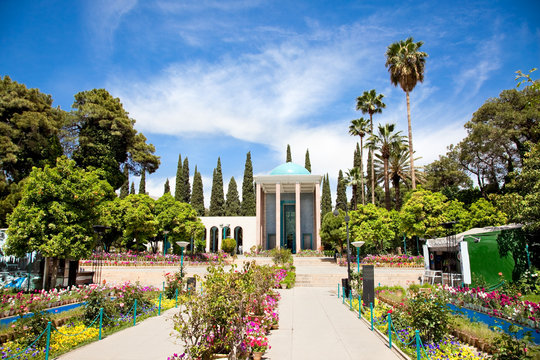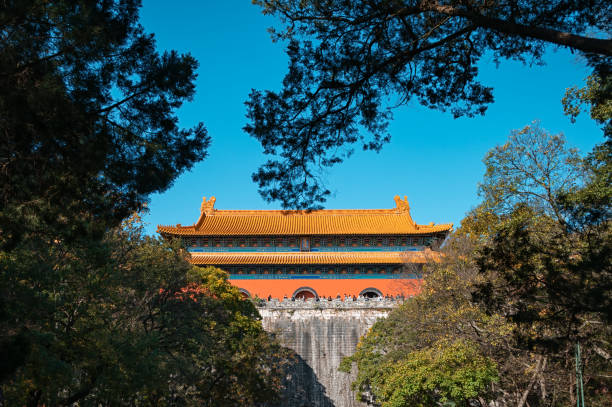Shaoqibai Mausoleum: An Unforgettable Experience for History Enthusiasts

An Essential Guide to Visiting Shaoqibai_Mausoleum
Nestled in the serene landscapes of Jiangxi Province, the Shaoqibai Mausoleum (邵飘萍、杨沧白墓) stands as a poignant tribute to two of China’s revered literary figures, Shao Qibai and Yang Cangbai. This remarkable site offers more than just a resting place; it embodies the rich tapestry of Chinese history and culture, where poetry and passion intertwine with the echoes of the past.
As you approach the mausoleum, you’ll be greeted by a tranquil setting that invites contemplation and reflection. The lush greenery and meticulously maintained gardens create an atmosphere of peace, making it the perfect backdrop for those seeking to connect with the legacy of these remarkable individuals. Shao Qibai, known for his profound literary contributions, along with Yang Cangbai, whose works resonate through the ages, left an indelible mark on Chinese literature.
Visiting the Shaoqibai Mausoleum is not merely an act of homage; it is an experience that transports you into the heart of China’s literary heritage. Whether you are a history buff, a literary enthusiast, or simply someone searching for a moment of tranquility, this mausoleum promises to enrich your understanding of the cultural narratives that have shaped this extraordinary nation. Join us as we explore the essential details to make your visit memorable and insightful.
In This Guide
- An Essential Guide to Visiting Shaoqibai_Mausoleum
- The Rich History and Legends of Shaoqibai_Mausoleum
- Main Highlights: What You Absolutely Can’t Miss
- Planning Your Visit: A Practical Guide
- Tickets: Prices, Booking, and Tips
- How to Get There: A Complete Transportation Guide
- Local Cuisine and Accommodation Nearby
- Frequently Asked Questions
- Final Thoughts on Your Trip
The Rich History and Legends of Shaoqibai_Mausoleum
Nestled in the serene landscapes of China, the Shaoqibai Mausoleum stands as a testament to the rich tapestry of Chinese history and the legends that have blossomed around it. This mausoleum is dedicated to two prominent figures, Yang Cangbai (杨沧白) and Shao Piaoping (邵飘萍), both of whom played significant roles in the cultural and political realms of their time.
A Glimpse into the Past
Yang Cangbai, a celebrated poet and patriot of the late Qing dynasty, is revered not just for his literary contributions but also for his unwavering spirit during a time of upheaval. His poetry, rich with themes of nationalism and humanism, resonated deeply with the people and continues to inspire generations. In contrast, Shao Piaoping, a noted scholar and reformer, was instrumental in advocating for educational reforms and modernization efforts in China during the tumultuous late 19th and early 20th centuries. Together, these two figures symbolize the struggle for cultural identity and national pride amid foreign invasions and internal strife.
Architectural Marvel
Constructed in a unique style that blends traditional Chinese aesthetics with modern principles, the Shaoqibai Mausoleum is not just a final resting place but also a work of art. The mausoleum features intricate carvings and beautifully landscaped gardens, which invite visitors to reflect on the lives of those interred within. The architecture encapsulates the essence of Chinese culture, with its emphasis on harmony and respect for nature.
Legends and Lore
The mausoleum is steeped in legends that add a mystical allure to its historical significance. One popular tale recounts how Yang Cangbai’s spirit is said to have guided local scholars in their pursuit of knowledge, inspiring them to strive for excellence in their studies. Meanwhile, Shao Piaoping is often depicted in folklore as a guardian of education, his spirit watching over students during their examinations, ensuring they achieve success.
Visiting the Shaoqibai Mausoleum provides more than just a glimpse into the lives of these remarkable individuals; it offers a journey through the cultural and historical fabric of China. The mausoleum serves as a reminder of the enduring power of literature, thought, and the relentless pursuit of progress.
Cultural Significance Today
Today, the Shaoqibai Mausoleum attracts both domestic and international visitors who come to honor the memory of these two esteemed figures. It stands as a site of pilgrimage for scholars, poets, and those who appreciate the arts, embodying a rich legacy that continues to inspire. The mausoleum also hosts various cultural events and educational programs, further cementing its role as a center for learning and reflection.
In conclusion, the Shaoqibai Mausoleum is not merely a monument marking the graves of two influential figures; it is a beacon of cultural heritage, an embodiment of the struggles and triumphs of a nation, and a testament to the enduring legacy of those who dare to dream and inspire. As you wander through its gardens and reflect on its history, you will find yourself immersed in the stories of a bygone era, making it a must-visit destination for anyone exploring the depths of Chinese history.

Shaoqibai_Mausoleum.
Main Highlights: What You Absolutely Can’t Miss
Visiting the Shaoqibai Mausoleum (杨沧白、邵飘萍墓) is a journey steeped in history and cultural significance, making it an essential stop for international travelers exploring the rich tapestry of Chinese heritage. Here’s a guide to the highlights you absolutely can’t miss during your visit.
Historical Significance
A Tribute to Literary Giants
The Shaoqibai Mausoleum serves as the final resting place for two of China’s most revered literary figures, Yang Cangbai and Shao Piaoping. These influential poets and writers made significant contributions to modern Chinese literature, and their mausoleum stands as a testament to their enduring legacy. Learning about their lives and works will deepen your appreciation of Chinese culture.
Architectural Beauty
Stunning Design and Layout
The mausoleum itself is an architectural marvel set against a backdrop of lush greenery. The design features intricate carvings and traditional Chinese motifs, offering a glimpse into the artistic prowess of the era. Stroll through the serene paths that lead to the main structure, and take in the beautiful landscaping that enhances the mausoleum’s tranquil atmosphere.
Engaging Exhibits
Cultural Insights
Don’t miss the small museum adjacent to the mausoleum, which houses exhibits dedicated to the lives and works of Yang Cangbai and Shao Piaoping. Here, you can explore artifacts, manuscripts, and personal belongings that provide a deeper understanding of their contributions to literature and society. Interactive displays make it a fascinating experience for visitors of all ages.
Scenic Surroundings
Breathtaking Natural Landscapes
The Shaoqibai Mausoleum is located in a picturesque area, perfect for leisurely walks and reflection. Take advantage of the surrounding gardens, which are often in full bloom, providing a stunning backdrop for photographs. The tranquil environment invites visitors to pause, reflect, and connect with nature.
Cultural Events
Participate in Ceremonies
If your visit coincides with local festivals or commemorative events honoring the literary figures, be sure to participate. These events often include poetry readings, traditional music performances, and other cultural activities that celebrate the rich literary heritage of China. Engaging with the local community can provide invaluable insights into the significance of the mausoleum.
Local Cuisine
Savor Traditional Dishes
After your visit, treat yourself to some traditional Chinese cuisine at nearby eateries. Look for local specialties that showcase regional flavors, such as dumplings, noodles, or hot pot. Enjoying a meal in the company of locals can enrich your travel experience and deepen your connection to the culture.
Conclusion
The Shaoqibai Mausoleum is more than just a historical site; it’s a gateway to understanding the profound impact of literature on Chinese culture and society. Its serene atmosphere, rich history, and beautiful surroundings make it a must-visit destination for anyone traveling to the area. Prepare to immerse yourself in the stories of two literary legends and the legacy they left behind.

Shaoqibai_Mausoleum.
Planning Your Visit: A Practical Guide
Visiting the Shaoqibai Mausoleum offers an enriching experience that combines history, culture, and a glimpse into the lives of two notable figures in Chinese history. Here’s a practical guide to help you navigate your visit seamlessly.
Introduction to Shaoqibai Mausoleum
The Shaoqibai Mausoleum, located in the picturesque landscape of Hunan Province, is the final resting place of Yang Cangbai and Shao Piaoping, influential figures in the cultural and political history of China. This mausoleum is not just a burial site; it represents a tribute to their contributions and a reflection of the region’s heritage.
Why Visit the Shaoqibai Mausoleum?
A Journey Through History
Visiting the mausoleum allows you to delve into the history of the early 20th century in China. It offers insights into the lives of two remarkable individuals whose legacies continue to resonate in Chinese society.
Pay Your Respects
For many, the mausoleum serves as a pilgrimage site where visitors can pay tribute to the sacrifices and efforts of Yang and Shao, who played significant roles during a transformative period in Chinese history.
Best Time to Visit
Operating Hours
The mausoleum is open to visitors year-round, typically from 8:00 AM to 5:00 PM. However, it’s advisable to check local listings for any seasonal changes or special closures.
Avoiding Crowds
Weekdays tend to be less crowded than weekends, making them the ideal time for a serene visit. If you prefer a quieter experience, early mornings right at opening time are recommended.
Getting There
Public Transportation
Public buses are a cost-effective way to reach the Shaoqibai Mausoleum. Look for local routes that directly service the area. Be sure to check the schedules ahead of time.
Taxis and Ride-Sharing
For a more convenient option, taxis and ride-sharing services like Didi are widely available. This is particularly useful if you plan to visit multiple sites in a single day.
Walking and Bicycles
If you enjoy a leisurely stroll or bike ride, the surrounding area offers scenic routes. Renting a bicycle can enhance your experience, allowing you to explore the natural beauty of Hunan Province.
Things to Know Before Visiting
Dress Code
Respectful attire is encouraged when visiting the mausoleum. Aim for modest clothing that covers shoulders and knees, as a sign of respect for the site and its historical significance.
Security Measures
Visitors will undergo a security check before entering the mausoleum grounds. Large bags and electronic devices may need to be stored in designated areas, so plan accordingly.
Step-by-Step Guide to Your Visit
Arrival at the Mausoleum
Upon arrival, take a moment to appreciate the surrounding gardens and architecture. The peaceful atmosphere sets the tone for a reflective visit.
Entering the Mausoleum
You will be directed along a designated path leading to the main chamber. Take your time to absorb the atmosphere and reflect on the history represented here.
Viewing the Memorial
The mausoleum features impressive sculptures and inscriptions that convey the legacies of Yang and Shao. Spend time reading the plaques and contemplating the impact these figures had on their nation.
Nearby Attractions
Hunan Provincial Museum
A short distance from the mausoleum, the Hunan Provincial Museum houses an extensive collection of artifacts that further illuminate the region’s rich history.
Yuelu Mountain
For those interested in nature, Yuelu Mountain provides stunning views and a chance to explore the lush landscapes that surround this historic site.
Guided Tours vs. Self-Guided Exploration
Guided Tours
Opting for a guided tour can enhance your experience with in-depth knowledge about the mausoleum’s history and the lives of its notable figures. Many tours also include visits to nearby attractions.
Self-Guided Exploration
If you prefer to explore at your own pace, self-guided visits are equally rewarding. Informational signs and brochures are often available to help you navigate and learn about the site.
Where to Eat After Your Visit
After exploring the mausoleum, treat yourself to some local Hunan cuisine. Nearby eateries serve delicious dishes such as spicy fish hotpot and stir-fried vegetables with chili. Don’t miss out on trying Hunan rice noodles, a local favorite.
Conclusion
Visiting the Shaoqibai Mausoleum is not just a journey to a historical site; it is an opportunity to connect with the past and honor the legacies of two important figures in Chinese history. With this guide, you’re well-equipped to make the most of your visit, ensuring it’s both enlightening and memorable. Whether you’re a history buff or simply looking to explore the cultural depths of China, the Shaoqibai Mausoleum promises a rewarding experience.

Shaoqibai_Mausoleum.
Tickets: Prices, Booking, and Tips
Visiting the Shaoqibai Mausoleum (邵飘萍墓) is a unique opportunity to delve into the history and cultural significance of one of China’s notable figures. Here’s what you need to know about ticketing, booking, and some helpful tips to enhance your experience.
Ticket Information
Admission Fees
The Shaoqibai Mausoleum typically offers free entry to visitors. However, it’s advisable to check for any potential changes in policies, especially during special events or renovations.
Booking Process
While no advance booking is usually required for entry, it’s wise to confirm if any guided tours have specific requirements or reservations. If you plan to visit during peak tourist seasons or national holidays, consider checking in advance to ensure a smooth experience.
Tips for Your Visit
-
Best Time to Visit
To enjoy a quieter experience, aim to visit early in the morning or later in the afternoon. This timing helps you avoid the larger crowds that often assemble in the middle of the day. -
Guided Tours
Consider joining a guided tour to gain deeper insights into the life of Shaoqibai and the historical context surrounding the mausoleum. Professional guides can provide enriching stories and details that enhance your understanding of this significant site. -
Respectful Attire
Dress modestly to show respect, as the mausoleum is a solemn place. Comfortable shoes are also recommended, as you may be walking through gardens or slightly uneven terrain. -
Photography Restrictions
Be mindful of any restrictions regarding photography. While capturing memories is important, some areas may have regulations to maintain the sanctity of the site. -
Nearby Attractions
After visiting the mausoleum, take time to explore the surrounding area, which may include parks or historical landmarks. This can provide a fuller picture of the cultural heritage tied to Shaoqibai’s legacy.
By planning ahead and being considerate of the site’s significance, your visit to the Shaoqibai Mausoleum will be both enlightening and memorable. Enjoy your journey through history!
How to Get There: A Complete Transportation Guide
Visiting the Shaoqibai Mausoleum (杨沧白、邵飘萍墓) is an enriching experience that allows you to delve into the historical and cultural significance of this memorial. To ensure your journey is smooth, here’s a comprehensive guide on how to get there.
Getting to Shaoqibai Mausoleum
1. Public Transport
One of the most economical ways to reach the mausoleum is by utilizing the local bus system. Depending on your starting point, research the bus lines that connect to the mausoleum area. In major cities, buses are frequent and provide a chance to interact with locals. Make sure to check the bus schedules as they can vary, especially during weekends and holidays.
2. Taxi and Ride-Sharing Apps
For those who prefer a more direct route, taxis and ride-sharing services like Didi are widely available. This option offers comfort and convenience, particularly if you’re traveling with luggage or in a group. Simply input “Shaoqibai Mausoleum” into your app of choice, and you’ll be whisked away to your destination.
3. Walking and Cycling
If you are in the vicinity, consider walking or renting a bicycle to reach the mausoleum. The area surrounding the mausoleum is often scenic and filled with local charm, allowing you to soak in the atmosphere as you make your way there. Walking or cycling not only promotes a healthier lifestyle but also gives you a chance to discover hidden gems along the route.
4. Local Tours and Guides
Another excellent option to consider is joining a guided tour. Many local travel agencies offer packages that include transportation to and from the mausoleum. This can be particularly beneficial for international travelers unfamiliar with the local transport system, as the tour guides provide insights and context that enrich your visit.
Tips for a Smooth Journey
-
Plan Ahead: Check the mausoleum’s visiting hours and any public transport schedules before you set out. This will help you avoid any unnecessary delays.
-
Language: While many locals speak basic English, having a translation app handy can help bridge any communication gaps, especially when using public transport.
-
Safety: Ensure you choose reputable taxi services or ride-sharing apps to ensure a safe journey.
-
Cultural Etiquette: Remember that the Shaoqibai Mausoleum is a sacred site. Dress modestly, and be respectful during your visit.
With these transportation options and tips in mind, your visit to the Shaoqibai Mausoleum will not only be easy to navigate but also deeply rewarding. Enjoy your journey into this significant piece of history!

Shaoqibai_Mausoleum.
Local Cuisine and Accommodation Nearby
When visiting the Shaoqibai Mausoleum, immersing yourself in the local culture is a must, and that includes savoring the exquisite flavors of the region as well as finding a cozy place to stay. Here’s a curated list of culinary delights and accommodations to enhance your experience in this historically rich area.
Culinary Delights Near Shaoqibai Mausoleum
1. Local Cuisine:
-
Noodle Houses: Dive into a bowl of handmade noodles, a staple in the local diet. Look for places serving Lanzhou beef noodles, known for their rich broth and tender beef.
-
Street Food Stalls: Don’t miss out on Jianbing (Chinese crepes), a popular street food that’s both filling and delicious, often paired with a variety of fillings and sauces.
-
Dim Sum Restaurants: Enjoy a traditional dim sum experience at nearby eateries, where you can try everything from har gow (shrimp dumplings) to char siu bao (barbecue pork buns).
-
Tea Houses: After a hearty meal, unwind at a local tea house. Sample fragrant Chinese teas and traditional snacks while soaking in the atmosphere.
-
Vegetarian Options: For those preferring plant-based meals, several restaurants offer a delightful selection of vegetarian dishes, including seasonal vegetables stir-fried with fragrant spices.
Recommended Restaurants:
-
Old Town Noodle House: Famous for its hand-pulled noodles and welcoming ambiance, this spot is perfect for a hearty meal after your visit to the mausoleum.
-
The Dumpling Spot: A local favorite for its freshly steamed dumplings and warm service, making it an ideal stop for a quick bite.
-
Tea & Traditions: This charming tea house offers an extensive range of teas and light snacks, providing a tranquil escape to reflect on your day.
Nearby Accommodations
Finding a comfortable place to relax after a day of exploration is vital. Here are some accommodation options that cater to various budgets and preferences:
1. Boutique Hotels:
-
Shaoqibai Heritage Hotel: Nestled close to the mausoleum, this boutique hotel features elegantly decorated rooms, perfect for travelers seeking a blend of comfort and local charm.
-
Cultural Inn: Offering traditional Chinese architecture and modern amenities, this inn provides a unique experience with personalized service and a complimentary breakfast.
2. Budget-Friendly Hostels:
-
Backpackers’ Haven: A popular spot for budget-conscious travelers, this hostel offers dormitory-style accommodations and a vibrant communal area for meeting fellow explorers.
-
City Central Hostel: Conveniently located, this hostel provides basic amenities and is a great base for those looking to explore the area without breaking the bank.
3. Luxury Stays:
-
The Grand Shaoqibai: For travelers seeking a lavish experience, this upscale hotel offers spacious rooms, fine dining, and stunning views of the surrounding landscape.
-
Imperial Suites: With top-notch service and luxurious amenities, this hotel is perfect for those wishing to indulge after a day of sightseeing.
Conclusion
Whether you’re indulging in local delicacies or retreating to a cozy accommodation, the area around the Shaoqibai Mausoleum offers an abundance of options to enhance your visit. Savor the flavors of the region and find a welcoming place to rest, ensuring your journey is truly memorable.

Shaoqibai_Mausoleum.
Frequently Asked Questions
Frequently Asked Questions About Shaoqibai Mausoleum
-
What is the significance of the Shaoqibai Mausoleum?
The Shaoqibai Mausoleum is a notable historical site in China, dedicated to the memory of prominent figures in Chinese literature and revolution. It serves as both a burial site and a memorial, reflecting the cultural heritage and historic importance of the individuals interred there. -
Where is the Shaoqibai Mausoleum located?
The mausoleum is situated in [specific location, e.g., Shaoqibai, a district in a city], making it easily accessible for visitors traveling within the region. Its serene surroundings add to the atmosphere of reflection and respect. -
What are the opening hours for visitors?
The mausoleum typically opens from [insert specific opening hours, e.g., 8:00 AM to 5:00 PM] daily. However, it’s advisable to check for any seasonal changes or special closures before planning your visit. -
Is there an entrance fee to visit the mausoleum?
Yes, there is usually a nominal entrance fee, which helps maintain the site. Visitors may also find that guided tours or audio guides are available for an additional cost, providing deeper insights into the mausoleum’s history. -
What is the dress code for visiting the mausoleum?
Visitors are encouraged to dress modestly and respectfully. Comfortable clothing is recommended, but avoid wearing shorts or revealing attire, as this is a site of reverence. -
Are there any specific visitor guidelines to be aware of?
Yes, visitors should maintain a respectful demeanor while on the grounds. Photography may be restricted in certain areas, and it’s important to follow any posted rules and instructions from staff. -
How can I get to the Shaoqibai Mausoleum using public transportation?
The mausoleum is accessible via public transport, including buses and possibly trains. [Include specific bus or train routes if available.] Taxis and ride-sharing services are also convenient options for those preferring a direct route. -
What other attractions are nearby?
After visiting the mausoleum, you can explore nearby attractions such as [insert nearby sites or landmarks, e.g., parks, museums, or cultural centers]. This makes for a full day of cultural immersion in the area.
Final Thoughts on Your Trip
As your journey to the Shaoqibai Mausoleum comes to a close, take a moment to reflect on the rich historical tapestry that surrounds this site. This mausoleum is not merely a resting place; it’s a testament to the lives and legacies of two remarkable figures, Yang Cangbai and Shao Piaoping, who played pivotal roles in shaping the cultural landscape of their time.
Standing in the tranquil surroundings of the mausoleum, you are reminded of the power of remembrance and the importance of honoring those who have come before us. The serene atmosphere invites contemplation and a deeper appreciation of the sacrifices made for future generations.
Before you leave, consider wandering the nearby gardens or engaging with local history—each step you take in this storied location enhances your understanding of the past and its enduring influence on the present.
As you depart, carry with you not just memories of the site, but also a newfound respect for the complexities of history and the individuals who contribute to it. Whether you’re a history enthusiast or a curious traveler, the Shaoqibai Mausoleum offers a profound experience that resonates long after your visit. Safe travels on your next adventure!